King salmon (onchorhynchus tshawytscha), known also as Chinook salmon, truly are the king of all salmon species in Alaska. Though distributed nearly state-wide, they particularly dominate the saltwater sport fishing roster as the most sought-after species available from Southeast Alaska into Prince William Sound, out to the Kodiak-Afognak island group and into the Bristol Bay area.

Kings are also high on the list for river anglers, as their large size and powerful runs make for some of the most exhilarating freshwater fishing in Alaska. Finally, they dominate the salmon market and the dinner table, being rich in omega-3 fatty acids. Any way you look at it, the king is a highly sought-after fish among Alaska anglers.
Distribution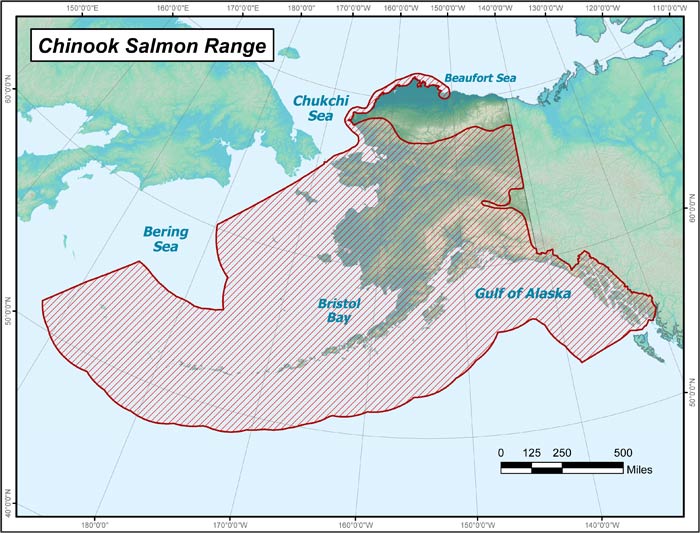
Kings are found from the California coast all the way to the Chukchi Sea, however sport anglers commonly encounter them in Southeast Alaska north to the Bristol Bay area. Most saltwater charter fishing takes place in Southeast, Prince William Sound, lower Cook Inlet and the Kodiak Island area. Freshwater angling for kings is popular in some Southeast streams, most notably the Taku and Stikine rivers. Farther north they are commonly pursued on tributaries to the Copper River, with the Gulkana receiving most of the action. Southcentral Alaska has historically had excellent runs of kings, however in recent years numbers have dwindled. Popular rivers in Southcentral are Anchorage's Ship Creek (hosting a planted run of kings), the Valley streams (Willow Creek, Little Willow Creek, the Little Susitna River, Montana Creek, Sheep Creek, Caswell Creek, Goose Creek, the Kashwitna River, and Sunshine Creek. Farther west, kings can be found in Talarik Creek, Chuitna River, Beluga River, Theodore River, Lewis River, McArthur River and the Kustatan River. These rivers all involve flying out of Anchorage, as there is no road access.
The Kenai Peninsula contains the legendary Kenai River, with it's two runs of large kings, together with the Anchor River and Deep Creek. The "Fishing Hole" on the Homer Spit, offers a shot at planted kings that return to the lagoon there in the summer months.
Tactics for Saltwater Kings
Kings are aggressive feeders along Alaska's coast, and can be caught using any of several boat-based or shore-based methods. Be geared up for all possibilities and don't be afraid to change tactics if one method doesn't produce after an hour or so.
Mooching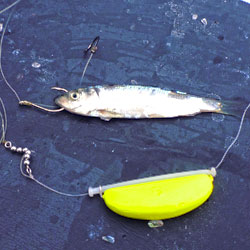
Perfected in the Pacific Northwest, mooching is a simple technique that will catch kings, other salmon species, along with rockfish, lingcod and even halibut. In its simplest form, bait is secured to a single or double-hook rig and lowered to a predetermined depth, where it is left to drift along with the boat, in the current. Sometimes mooching can be combined with slow jigging techniques, to draw more attention to the bait. The only tackle required for mooching for kings is a supply of 4/0-5/0 Siwash hooks, a spool of 40# test leader material, and an assortment of banana weights with bead chain to secure the leader. Leader length can vary, but should be between three and six feet in length. Herring is the usual bait, and can be rigged either whole or plug-cut. Secure it so the herring rolls slowly as it is dragged through the water.
Trolling
Trolling offers the opportunity to cover more ground while presenting your offering with a bit more action. Because kings often run at the same time as other salmon species, it's important to target them. This is made fairly simple, as kings usually run deeper than silvers, chums or pinks, the other species that can be encountered while you're trolling for kings.
There are several methods to rig up for trolling. The simplest is to use the same rig you use for mooching, but troll it as a flat line off the stern of the boat. Control your depth by reducing or increasing the amount of weight used, and by adjusting the distance from the stern. In most cases you will run your flat lines beyond the last waves of your wake, or between 60-80 feet behind the boat. Colored sinkers are sometimes used to draw more attention to your offering, but it's not essential.
Another way to rig your flat lines is to use a diver instead of a trolling weight. This pulls your line down from the surface to about 20'-30'
The next method is to use a down rigger to bring your line down to the depth the kings are running. If you are using a fish finder, you should be able to determine the exact depth. If you don't have a fish finder, you will have to prospect by running your down riggers at a couple of different depths, and possibly a couple of flat lines with different amounts of weight. This staggers your offerings at different depths, increasing your chances of finding fish. Terminal rigs include the following setups:
- Herring. Use a six-foot leader to a ball-bearing swivel, double hooks (4/0 upper and 5/0 lower) and 40# leader material. Plug-cut your herring so it will roll and secure the line to your down rigger.
- Flasher / hoochie. Rig up the same way as #1, but the leader can be between 4' and 6'. Secure the leader to the swivel on the flasher, and secure your main line to the swivel at the other end of the flasher. Give yourself about six or eight feet of line between the flasher and the downrigger clip. Hoochie colors can vary; generally go with bright colors on cloudy days and darker colors on bright days.
Trolling Tackle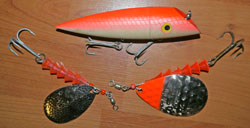
Tackle used for trolling consists of simple rigs like the plug-cut herring (which can be trolled by itself or with a flasher), flasher rigs with hoochies, plugs, spinners or spoons. Each has it's time and place, and each has its own local following. That's one thing you will discover when you're fishing the salt for kings; every area of the state seems to have its own local tactics. Don't be afraid to change it up though; something that has worked in one area will probably work elsewhere. Your best bet is to identify four or five primary "go-to" setups that work for you, and gear up for those. Make up a tackle box specifically for your trolling gear so you have everything with you on the water. At a minimum you should have 2-3 spools of leader material, 100 hooks in assorted sizes, ball bearing swivels, several sizes and colors of flashers, a half-dozen each of plugs, spinners and spoons in various sizes and colors and an assortment of banana (trolling) weights with bead chain swivels attached. Weights should range in size from 4oz to 12oz. Don't forget to toss in a half-dozen packages of hoochies in various sizes and colors.
Saltwater King Salmon Tackle Box
- Gibbs / Delta Flashers: 6 ea., red/green, green/silver, blue.
- Hotspot Flasher: 6 ea., chartreuse, white glow, white silver mylar, green mirror, strawberry, red racer, white glow jelly u/v
- Silver Horde Octopus trolling squid, 3.5: 6 pkg; one each in pink, purple, green, blue u/v, chartreuse u/v, black green glow.
- Silver Horde Twinkle skirt: 4 pkg.
- Ace High Fly trolling skirts: 12 ea. assorted colors
- Owner Gorilla bait hooks 4/0. 5/0: 24 ea.
- Gamakatsu Octopus hooks 4/0, 5/0: 24 ea.
- Removable splitshot: assorted sizes
- Rubber Core Sinkers: 6 ea. 1 oz., 2 oz., 4 oz.
- Banana weights with bead chain: 4 ea. 3 oz., 4 oz., 6 oz.
- Sampo ball-bearing coastlock swivels: 12 ea.
- Leader material: 30 lb.
- Pink Lady diver: 2 ea.
- Luhr Jensen Tee Spoon: 4 ea., assorted colors
- Luhr Jensen Krocodile Spoon: 4 ea, assorted sizes and colors
- Luhr Jensen J-Plug: 6 ea., cut plug, trapper, mongoose, everglow
- Silver Horde Kingfisher spoon: 6 ea. assorted colors
Shore Fishing
There are not many shore-based saltwater king salmon opportunities in Alaska, but the few that exist can be quite good. The Ketchikan road system has some options, as do the Kenai Peninsula (Deep Creek / Ninilchik area) and Kodiak Island. The standard methods include bait fishing with herring and casting heavy spoons and plugs. Use a longer rod in the 12'-14' range, with 20# monofilament or a baitcaster with braid. Bait fishermen often pick up other species while fishing for kings; it's not uncommon to catch starry flounder, rockfish and even halibut. Popular spoons include the Blue Fox Pixee, an old Alaska Standby, and the Krocodile. For spinners, it's hard to beat the Blue Fox Vibrax. Bring an assortment of each. Flame orange, chartreuse and green are the most popular colors.
Shore-based Saltwater King Salmon Tackle Box
- Owner Gorilla bait hooks 4/0. 5/0: 24 ea.
- Gamakatsu Octopus hooks 4/0, 5/0: 24 ea.
- Removable splitshot: assorted sizes
- Rubber Core Sinkers: 6 ea. 1 oz., 2 oz., 4 oz.
- Banana weights with bead chain: 4 ea. 3 oz., 4 oz., 6 oz.
- Fishing floats
- Sampo ball-bearing coastlock swivels: 12 ea.
- Leader material: 30 lb.
- Luhr Jensen Krocodile Spoon: 4 ea, assorted sizes and colors
- Silver Horde Kingfisher spoon: 6 ea. assorted colors
- Blue Fox Pixee spoon: 6 ea. 7/8 oz., 1/2 oz. Flame insert, green insert, chartreuse insert
- Blue Fox Vibrax spinner: 6 ea. #3, #5, assorted colors
Tactics for Freshwater Kings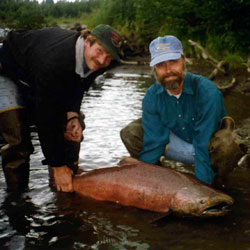
Catching kings in the river system can get very exciting in a hurry, as the fish have the current to work with, often spooling an angler before they can get the fish under control. You need a stout rod and heavy line, especially if you're fishing from shore. Let's have a look at boat-based king fishing and then we'll talk about fishing from the bank.
Boat-Based River Fishing
Whether you're fishing from a drift boat / raft or from a powerboat, there are two basic methods for catching river kings; drifting and back-trolling. Each can be modified to an extent, but the point of each is to get your offering as deep as possible, into holding water. Kings run in the deepest channels as a rule, and because they are so large, the current can push them around a bit. So they prefer deeper holes and runs, where structure on the bottom breaks the current up and enables them to better hold in the current. Kings are sometimes caught as they move between holes, but successful river king fishermen know how to work the deep holes, eddies and runs.
Drifting
Sometimes called "back bouncing", drifting for kings involves drifting with the current, while your bait or lure skims along the bottom. There are several ways to rig up. In most cases you will use a double hook setup comprised of a 4/0 upper hook and a 5/0 lower hook and a 40# leader that's about three or four feet in length. Some anglers on the Kenai, where very large kings over 50# are encountered, beef it up a bit with 50# leaders and larger hooks. At that point you will decide what kind of attractor you will use. If you're fishing with cured roe as bait, you can wrap a quarter-sized chunk in a small square of mesh roe cloth and slip that through the egg loop on your upper hook. Then you will add your yarn or other attractors. In cases where bait is not allowed, go with the attractors alone. Common attractors used in Alaska are Spin-N-Glos, Corkies and yarn. Color choices are driven by angler preference to a large degree, but generally, muted colors are used on bright days and clear water, and brighter colors are
used in murky water or on cloudy days. The three keys to effective drifting are:
- Know where the holes and runs are. Don't waste your time fishing where there are no fish!
- Use the right amount of weight. Too much lead and you'll get snagged. Too little and your rig will drift above the fish. Get in the zone!
- Stick with the hot colors and sizes. A fisherman with a tackle box full of different sizes and colors of attractors will tend to use them all. This translates to lots of time wasted re-rigging. Fish can't strike your lure if it's not in the water!
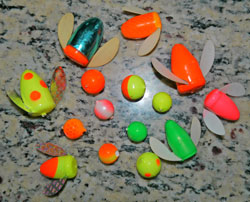 |
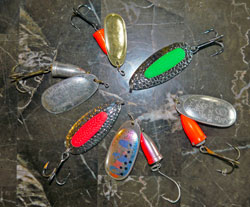 |
| Popular colors of Spin-N-Glo lures and Corkies used for king salmon fishing. | Common sizes and colors of spoons and spinners used to catch king salmon in Alaska's rivers. |
 |
 |
| Setup used for larger kings on the Kenai River. | The Wiggle Wart is a popular diving plug used in Alaska for river king salmon fishing. |
Back-Trolling
This method is very similar to trolling in saltwater, with one critical exception: you use the speed of the current to keep your lure in the strike zone, and use the boat's motor to slow your drift. Anglers experienced in back-trolling can work every inch of a hole by adjusting their speed and direction. Allow the current to push your boat Float used for fishing for Alaska king salmon downstream very slowly, working the hole back and forth until you are out of holding water. In some cases you might opt to hold in one spot for a while. In places like that, you could consider anchoring and shutting the motor off. Terminal gear for back-trolling includes Spin-N-Glo lures, Corkies or yarn fished behind a diver, or diving plugs that are capable of getting into the depths where the fish are. Note that some rivers carry a single-hook restriction. In such places, be sure to carry along a supply of split rings and single hooks. Treble hooks are very effective in catching kings, but they do a lot of damage. If you're planning to release your fish, go with single hooks even if trebles are legal. If you are fishing a river that has a lot of aquatic vegetation drifting downstream, place a removable split shot about five or six feet from your lure; the lead will catch weeds that would otherwise drift down your line and ruin the action of your lure.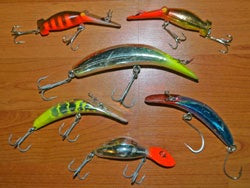
Some lures, such as the Flatfish or the Kwikfish, allow the use of scent as an attractant. Fillet a fresh bait herring, lay the fillet along the back of the lure and wrap it with cotton thread to secure it. Naturally, this method is not legal in areas where bait is prohibited. Other lures use sound as an attractant / irritant. The Wiggle Wart is a great example that has produced many king catches. It has a rattle inside that drives kings crazy!
River Boat Fishing King Salmon Tackle Box
- Gamakatsu Octopus hooks: 4/0, 5/0: 24 ea.
- Gamakatsu Siwash hooks: 4/0
- Salmon Roe (where legal)
- Removable splitshot: assorted sizes
- Rubber Core Sinkers: 6 ea. 1 oz., 2 oz., 4 oz.
- Banana weights with bead chain: 4 ea. 3 oz., 4 oz., 6 oz.
- Sampo ball-bearing coastlock swivels: 12 ea.
- Snaps: 12 ea.
- Leader material: 30 lb.
- Luhr Jensen Jet Diver: 3 ea.
- Luhr Jensen Krocodile Spoon: 4 ea, assorted sizes and colors
- Luhr Jensen J-Plug: 6 ea., cut plug, trapper, mongoose, everglow
- Silver Horde Kingfisher spoon: 6 ea. assorted colors
- Luhr Jensen Quikfish Plug, K-15, K-16, K-16X, 6 ea.
- Storm Magnum Wiggle Wart Plug, 6 ea.
- Luhr Jensen Hot Shot Plug, 6 ea.
- Spin-n-Glo: 12 ea. sixe 00, 000, assorted colors
- Lil' Corky: 24 ea. assorted sizes and colors.
- Red spacer beads (for between Spin-n-Glo and hook): 24 ea.
Bank Fishing For King Salmon
Some areas lend themselves very well to shore-based river fishing. Large pools or eddies can be ideal, but don't overlook runs where fish might hold at or near the bottom for a bit as they move upstream. Common techniques involve bouncing Spin-n-Glos, Corkies, yarn or cured roe along the bottom or fishing roe under a float in calm water where kings sometimes cruise around higher in the water column. Here's how to rig for bank fishing:
Drift Rigs
Slide a 1" section of surgical tubing onto your main line, and tie a ball-bearing cross-lock swivel to the end of the main line. Don't use a regular gated swivel! Kings are very strong, and they will straighten out a regular swivel. Use a locking swivel instead. The swivel allows you to change rigs without re-tying everything, and the surgical tubing holds a section of lead of whatever length you need in place on your line. Start off with a little more lead than you think you need, and trim it back if you find that the rig is not bouncing along the bottom as it should. Rig up a leader with two single hooks. The upper hook should have an egg loop in it, to allow you to secure roe / yarn to the line. Slide your Corkie or Spin-n-Glo onto the leader, so it rests against the hook eye, and secure the other end of the leader to the snap swivel at the end of your main line. If you're using a Spin-n-Glo, slide a small bead onto your leader before you slide the lure on; the bead allows the Spin-n-Glo to rotate properly in the current, against the hook eye. Double Spin-n-Glos can also be used, with a bead in between each. This drift rig can be used with or without bait, or with any combination of bait, yarn, Corkies or Spin-n-Glo lures.
An alternative way to secure your weight is to tie a three-way swivel to your main line. Tie a short section of leader to the dropper end of the swivel, and secure a teardrop sinker to the dropper. Alternatively you can crimp a section of hollow lead to the dropper, which allows you to adjust the quantity of weight without re-tying. Secure your leader to the inline eye on the swivel. This rig involves more knots, thus more chances of failure. Additionally, the distance between the weight and the lure cannot be adjusted without re-tying. With the lead / surgical tubing setup, you can slide the lead up or down the line as needed. Additionally, if your weight hangs up on the bottom, it will slide down the line to the hooks as you pull on it, and will often come free.
If you use the lead / surgical tubing setup, round the end of the lead with your pliers before inserting it into the tubing. This prevents nicks in your line from the sharp edge of the lead where it was cut.
Float Rigs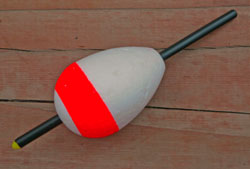
One of the recent trends in king fishing involves the use of bobbers. The concept is to float your offering just off the bottom, and it can be used in either moving or still water. Bobbers are generally more effective than weights in avoiding snags on the bottom, so they are often used for fishing outside corners, where the water is deeper and the current has scoured out tree roots and such. These areas often have tree branches on the bottom and a drift rig would become snagged. The float rig, properly adjusted, suspends your bait or lure above the snags.
Float rigs are used mostly for fishing with roe (Corkies and Spin-n-Glos float, so they don't work too well with float setups). All you need is the float and a double hook setup with an egg loop, plus a swivel to secure the leader to your main line and a couple of split shot to keep the offering at depth. Toss in two or three floats, the hooks, swivels and sinkers into your river king tackle box and you're set.
Spinners and Spoons
Spinners such as the Blue Fox Vibrax and spoons like the Blue Fox Pixee can be deadly for river kings. Rig one up by tying a cross-lock swivel directly to your main line. Clip the lure directly to the swivel and you're set. Color can make a big difference, as can weight. Set up for your trip by including a dozen in assorted sizes and colors; popular colors are flame orange, chartreuse and green.
Plugs
If the river you are fishing offers points of land projecting into the main flow, with an eddy on the downstream side, you could have an ideal place from which to run plugs from the bank. Deep holes form where eddies exist, and by walking out to the end of the point, your can run your plug along the seam between the eddy and the main current where fish position themselves prior to making the run upstream. Choose deep divers such as the Wiggle Wart or Tadpolly for the best results.
No swivel is needed for running plugs; simply install a cross-lock snap at the end of your line and clip the lure directly to the eye on the plug. Note that some plugs don't run straight when they're new, and it may be necessary to bend the eye on the plug so it runs true. Also if weeds are a problem in the river, clamp a splitshot on your main line about five feet from the plug. As weeds encounter your line, they will slide down and stop at the split shot instead of fouling your lure.
Bank Fishing King Salmon Tackle Box
- Gamakatsu Octopus hooks: 4/0, 5/0: 24 ea.
- Gamakatsu Siwash hooks: 4/0
- Salmon Roe (where legal)
- Removable splitshot: assorted sizes
- Rubber Core Sinkers: 6 ea. 1 oz., 2 oz., 4 oz.
- Banana weights with bead chain: 4 ea. 3 oz., 4 oz., 6 oz.
- Sampo ball-bearing coastlock swivels: 12 ea.
- Snaps: 12 ea.
- Leader material: 30 lb.
- Fishing floats
- Luhr Jensen Krocodile Spoon: 4 ea, assorted sizes and colors
- Silver Horde Kingfisher spoon: 6 ea. assorted colors
- Luhr Jensen Quikfish Plug, K-15, K-16, K-16X, 6 ea.
- Storm Magnum Wiggle Wart Plug, 6 ea.
- Luhr Jensen Hot Shot Plug, 6 ea.
- Spin-n-Glo: 12 ea. sixe 00, 000, assorted colors
- Lil' Corky: 24 ea. assorted sizes and colors.
- Red spacer beads (for between Spin-n-Glo and hook): 24 ea.
Fly Patterns for River Kings
Fly fishing for king salmon is serious business, requiring beefy rods, reels with solid drags and a strong back to muscle fish out of deep holes. It's the big-game fishing experience of Alaska! Popular fly patterns run the gamut from attractors to muted patterns and egg imitations. Some of the most popular patterns include Glo-Bugs, Popsicles, Teeny Nymphs, Wooly Buggers, Wiggle Tails, Flash Flies, Everglo Flies and some of the brighter patterns used for tarpon fishing. Use smaller, darker patterns in clear or shallow water or on sunny days, and go with the big, gaudy patterns on darker days or turbid water.






















